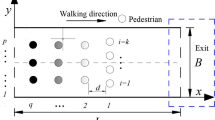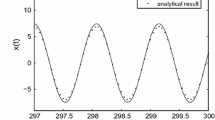Abstract
More realistic results of the random crowd-structural interaction dynamic response calculations are crucial for structural vibration analysis and control. And ignoring interactions is considered a conservative approach. This paper analyzes the effect of obstacles and semi-rigid boundary conditions on the random crowd-structure interaction vibration of the floor. The social force model is used to simulate crowd walking randomly in the room, and simulation results are matched with the dynamic calculation of the floor, thus establishing the time-varying dynamic calculation model of crowd-structure interaction. The differential quadrature method and mode analysis method are used to solve the dynamic equations. In addition, the effect of crowd random walking in an environment with obstacles on the time-varying parameters and dynamic response of the floor is discussed. The results show: (a) With the random walking of pedestrians, the floor fundamental frequency first decreases and then increases compared with the no-load, while the change of damping ratio is the opposite. Furthermore, the variation of floor fundamental frequency and damping ratio is greater in the empty classroom (without obstacles) than in the discussion room layout (with obstacles) due to the obstacles. (b) Analyzing the variation of the acceleration response of the floor under the two layouts, it can be found that the installation of obstacles can improve the human-induced vibration of the floor. (c) The vibration problem of the floor can be effectively improved by changing the stiffness ratio in semi-rigid constraint, which provides another idea for the vibration control of the floor.



















Similar content being viewed by others
References
Bazli, M., Heitzmann, M., Ashrafi, H.: Long-span timber flooring systems: a systematic review from structural performance and design considerations to constructability and sustainability aspects, 48, 103981 (2022). https://doi.org/10.1016/j.jobe.2021.103981
Gong, M., Li, Y., Shen, R., Wei, X.: Glass suspension footbridge: human-induced vibration, serviceability evaluation, and vibration mitigation. J. Bridg. Eng. 26, 05021014 (2021). https://doi.org/10.1061/(asce)be.1943-5592.0001788
Hassanieh, A., Chiniforush, A.A., Valipour, H.R., Bradford, M.A.: Vibration behaviour of steel-timber composite floors, part (2): evaluation of human-induced vibrations. J. Constr. Steel Res. 158, 156–170 (2019). https://doi.org/10.1016/j.jcsr.2019.03.026
Huang, H., Gao, Y., Chang, W.S.: Human-induced vibration of cross-laminated timber (CLT) floor under different boundary conditions. Eng. Struct. 204, 110016 (2020). https://doi.org/10.1016/j.engstruct.2019.110016
Liu, K., Liu, L., Zhu, Q., Zhou, F.: Dynamic testing and numerical simulation of human-induced vibration of cantilevered floor with tuned mass dampers. Structures. 34, 1475–1488 (2021). https://doi.org/10.1016/j.istruc.2021.08.079
Li, Y., Chen, M., Zheng, X., Dou, Z., Cheng, Y.: Relationship between behavior aggressiveness and pedestrian dynamics using behavior-based cellular automata model. Appl. Math. Comput. 371, 124941 (2020). https://doi.org/10.1016/j.amc.2019.124941
Schimit, P.H.T.: A model based on cellular automata to estimate the social isolation impact on COVID-19 spreading in Brazil. Comput. Methods Programs Biomed. 200, 105832 (2021). https://doi.org/10.1016/j.cmpb.2020.105832
Zeng, J., Qian, Y., Mi, P., Zhang, C., Yin, F., Zhu, L., Xu, D.: Freeway traffic flow cellular automata model based on mean velocity feedback. Phys. A Stat. Mech. its Appl. 562, 125387 (2021). https://doi.org/10.1016/j.physa.2020.125387
Taherifar, N., Hamedmoghadam, H., Sree, S., Saberi, M.: A macroscopic approach for calibration and validation of a modified social force model for bidirectional pedestrian streams. Transp. A Transp. Sci. 15, 1637–1661 (2019). https://doi.org/10.1080/23249935.2019.1636156
Saboia, P., Goldenstein, S.: Crowd simulation: applying mobile grids to the social force model. Visual Comput. 28, 1039–1048 (2012)
Yang, X., Yang, X., Li, Y., Zhang, J., Kang, Y.: Obstacle avoidance in the improved social force model based on ant colony optimization during pedestrian evacuation. Phys. A Stat. Mech. Appl. 583, 126256 (2021). https://doi.org/10.1016/j.physa.2021.126256
Wu, W., Li, J., Yi, W., Zheng, X.: Modeling crowd evacuation via behavioral heterogeneity-based social force model. IEEE Trans. Intell. Transp. Syst. 23, 15476–15486 (2022). https://doi.org/10.1109/TITS.2022.3140823
Prédhumeau, M., Dugdale, J., Spalanzani, A.: Adapting the social force model for low density crowds in open environments. In: Springer Proceedings in Complexity, pp. 519–531 (2021)
Tian, Q., Xu, Y.: Cellular automaton simulation of emergent evacuation considering the classroom seats arrangement. In: 3rd International Joint Conference on Computational Sciences and Optimization, CSO 2010: Theoretical Development and Engineering Practice, Vol. 2, pp. 523–526. (2010)
Fujino, Y., Pacheco, B.M., Nakamura, S.-I., Warnitchai, P.: Synchronization of human walking observed during lateral vibration of a congested pedestrian bridge. Earthq. Eng. Struct. Dyn. 22, 741–758 (1993). https://doi.org/10.1002/eqe.4290220902
Xie, Z., Hu, X., Du, H., Zhang, X.: Vibration behavior of timber-concrete composite floors under human-induced excitation. J. Build. Eng. 32, 101744 (2020). https://doi.org/10.1016/j.jobe.2020.101744
Zhu, Q., Liu, K., Liu, L., Du, Y., Zivanovic, S.: Experimental and numerical analysis on serviceability of cantilevered floor based on human-structure interaction. J. Constr. Steel Res. 173, 106184 (2020). https://doi.org/10.1016/j.jcsr.2020.106184
Ma, R., Ke, L., Wang, D., Chen, A., Pan, Z.: Experimental study on pedestrians’ perception of human-induced vibrations of footbridges. Int. J. Struct. Stab. Dyn. 18, 1850116 (2018). https://doi.org/10.1142/S021945541850116X
Moutinho, C., Pereira, S., Cunha, Á.: continuous dynamic monitoring of human-induced vibrations at the Luiz I bridge. J. Bridg. Eng. 25, 05020006 (2020). https://doi.org/10.1061/(asce)be.1943-5592.0001580
Cai, Y., Gong, G., Xia, J., He, J., Hao, J.: Simulations of human-induced floor vibrations considering walking overlap. SN Appl. Sci. 2, 1–15 (2020). https://doi.org/10.1007/s42452-019-1817-1
Zhu, Q., Yang, W., Zhang, Q., Du, Y.: A hybrid vibration mitigation method based on the crowd flow control and tuned mass damper on a footbridge. Eng. Struct. 245, 112972 (2021). https://doi.org/10.1016/j.engstruct.2021.112972
Zhang, S., Xu, L., Qin, J.: Vibration of lightweight steel floor systems with occupants: Modelling, formulation and dynamic properties. Eng. Struct. 147, 652–665 (2017). https://doi.org/10.1016/j.engstruct.2017.06.008
Nyawako, D., Reynolds, P., Hudson, M.: Findings with AVC Design for Mitigation of Human Induced Vibrations in Office Floors. In: Conference Proceedings of the Society for Experimental Mechanics Series, pp. 37–44 (2013).
Kaveh, A., Fahimi Farzam, M., Hojat Jalali, H., Maroofiazar, R.: Robust optimum design of a tuned mass damper inerter. Acta Mech. 231, 3871–3896 (2020). https://doi.org/10.1007/s00707-020-02720-9
dos Santos, M.D.S., Lima, D.V.F., Carmona, J.E.C., Avila, S.M., de Carvalho, G.N.D.: Vibration control of a gym floor using tuned mass dampers: a numerical analysis. Mod. Mech. Eng. 03, 9–16 (2013). https://doi.org/10.4236/mme.2013.33a002
Nguyen, T.H., Saidi, I., Gad, E.F., Wilson, J.L., Haritos, N.: Performance of distributed multiple viscoelastic tuned mass dampers for floor vibration applications. Adv. Struct. Eng. 15, 547–562 (2012). https://doi.org/10.1260/1369-4332.15.3.547
Wang, X., Pereira, E., García-Palacios, J.H., Díaz, I.M.: A general vibration control methodology for human-induced vibrations. Struct. Control Heal. Monit. 26, e2406 (2019). https://doi.org/10.1002/stc.2406
Helbing, D., Farkas, I., Vicsek, T.: Simulating dynamical features of escape panic. Nature 407, 487–490 (2000). https://doi.org/10.1038/35035023
Hardmeier, H., Jenal A., Küng B., Thaler F.: Lecture with Computer Exercises: Modelling and Simulating Social Systems with MATLAB—Modelling Situations of Evacuation in a Multi-level Building. Technical Report, Zurich (2012). http://download.hanshardmeier.ch/report.pdf
Venuti, F., Tubino, F.: Human-induced loading and dynamic response of footbridges in the vertical direction due to restricted pedestrian traffic. Struct. Infrastruct. Eng. 17, 1431–1445 (2021). https://doi.org/10.1080/15732479.2021.1897630
Živanović, S.: Benchmark footbridge for vibration serviceability assessment under the vertical component of pedestrian load. J. Struct. Eng. 138, 1193–1202 (2012). https://doi.org/10.1061/(asce)st.1943-541x.0000571
Ingólfsson, E.T., Georgakis, C.T.: A stochastic load model for pedestrian-induced lateral forces on footbridges. Eng. Struct. 33, 3454–3470 (2011). https://doi.org/10.1016/j.engstruct.2011.07.009
Van Nimmen, K., Zhao, G., Seyfarth, A., Van den Broeck, P.: A robust methodology for the reconstruction of the vertical pedestrian-induced load from the registered body motion. Vibration. 1, 250–268 (2018). https://doi.org/10.3390/vibration1020018
Kerr, S.C., Bishop, N.W.M.: Human induced loading on flexible staircases. Eng. Struct. 23, 37–45 (2001). https://doi.org/10.1016/S0141-0296(00)00020-1
Wang, J., Chen, J.: A comparative study on different walking load models. Struct. Eng. Mech. 63, 847–856 (2017). https://doi.org/10.12989/sem.2017.63.6.847
Venuti, F., Bruno, L.: An interpretative model of the pedestrian fundamental relation. Comptes Rendus - Mec. 335, 194–200 (2007). https://doi.org/10.1016/j.crme.2007.03.008
da Silva, F.T., Brito, H.M.B.F., Pimentel, R.L.: Modeling of crowd load in vertical direction using biodynamic model for pedestrians crossing footbridges. Can. J. Civ. Eng. 40, 1196–1204 (2013). https://doi.org/10.1139/cjce-2011-0587
Bellman, R., Kashef, B.G., Casti, J.: Differential quadrature: a technique for the rapid solution of nonlinear partial differential equations. J. Comput. Phys. 10, 40–52 (1972). https://doi.org/10.1016/0021-9991(72)90089-7
Bert, C.W., Wang, X., Striz, A.G.: Static and free vibrational analysis of beams and plates by differential quadrature method. Acta Mech. 102, 11–24 (1994). https://doi.org/10.1007/BF01178514
Bert, C.W., Malik, M.: Differential quadrature method in computational mechanics: a review. Appl. Mech. Rev. 49, 1–28 (1996). https://doi.org/10.1115/1.3101882
Shu, C., Du, H.: Implementation of clamped and simply supported boundary conditions in the GDQ free vibration analysis of beams and plates. Int. J. Solids Struct. 34, 819–835 (1997). https://doi.org/10.1016/S0020-7683(96)00057-1
Zhang, S.: Vibration Serviceability of Cold-Formed Steel Floor Systems. University of Waterloo, Canada (2017)
Acknowledgements
This work was supported by National Natural Science Foundation of China (52168041, 12062011) and Gansu Province Science and Technology Foundation for Youth (21JR7RA557). Moreover, the authors are thankful for the literature regarding model verification on benchmark structures.
Author information
Authors and Affiliations
Corresponding author
Additional information
Publisher's Note
Springer Nature remains neutral with regard to jurisdictional claims in published maps and institutional affiliations.
Rights and permissions
Springer Nature or its licensor (e.g. a society or other partner) holds exclusive rights to this article under a publishing agreement with the author(s) or other rightsholder(s); author self-archiving of the accepted manuscript version of this article is solely governed by the terms of such publishing agreement and applicable law.
About this article
Cite this article
Pu, X., He, T. & Zhu, Q. Considering the effect of obstacles and semi-rigid boundary conditions on the dynamic response of the floor under random crowd-structure interaction. Acta Mech 234, 3821–3841 (2023). https://doi.org/10.1007/s00707-023-03595-2
Received:
Revised:
Accepted:
Published:
Issue Date:
DOI: https://doi.org/10.1007/s00707-023-03595-2




